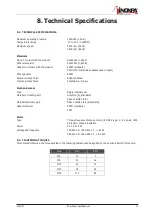
2015/01
7.Maintenance
13
7.
Maintenance
7.1.
GENERAL CONSIDERATIONS
This pump, just like any other machine, requires maintenance. The instructions contained in this manual cover the
identification and replacement of spare parts. The instructions are aimed at maintenance personnel and those
responsible for the supply of spare parts.
Carefully read Chapter 8.
H
Technical Specifications
.
All replaced material should be duly disposed of/recycled according to the directives in force in each area.
ALWAYS disconnect the pump before beginning any maintenance work.
7.1.1.
Check the mechanical seal
Periodically check that there are no leaks around the shaft. If leakage is detected through the mechanical seal, replace
it following the instructions in the section Assembly and Disassembly.
7.2.
STORAGE
Before storing the pump it should be completely drained. Prevent as far as possible exposing the parts to excessively
humid environments.
7.3.
CLEANING
The use of aggressive cleaning products such as caustic soda and nitric acid may burn the skin.
Use rubber gloves during the cleaning process.
Always use protective goggles.
7.3.1.
CIP (Clean-in-Place) cleaning
If the pump is installed in a system with a CIP process, its removal will not be required. If an automatic
cleaning process is not available, disassemble the pump as indicated in the section
Assembly and Disassembly
.
Cleaning solutions for CIP processes.
Only use clear water (chlorine-free) to mix with the cleaning agents:
a) Alkaline solution:
1% by weight of caustic soda (NaOH) at 70ºC (150ºF)
1 kg NaOH + 100 litres of water = cleaning solution
or
2.2 litres of 33% NaOH + 100 litres of water = cleaning solution
b) Acid solution:
0.5% by weight of nitric acid (HNO
3
) at 70ºC (150ºF)
0.7 litres of 53% HNO
3
+ 100 litres of water = cleaning solution





































